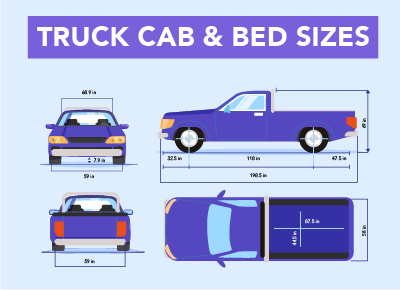Which Truck Cab and Bed Sizes Are Right For You?
January 30, 2021
I am a serial entrepreneur and a consumer advocate. When I’m not helping car buyers, I love working on ventures that have a positive impact. I run a cause marketing agency and serve on the board of Vayu Global Health where we are disrupting the medical industry and preventing the needless deaths of mothers and babies during childbirth.

Things can get pretty confusing when trying to determine which cab and bed size is right for you. And that doesn't even include terms like 1/2 ton or 3/4 ton trucks.
There are plenty of different cab and bed setups, and some bed lengths are only available with certain cab sizes.
To help with your next truck purchase, we'll break down the basics for truck cabs and beds along with a few key tips to help you choose the best configuration for you.
Need help picking out the right truck model? Check out our list of the best trucks available right now.
Table of Contents
- Understanding Truck Cab & Bed Sizes Video
- Truck Cab & Bed Size Chart
- What Are the Different Types of Truck Cabs?
- Crew Cab vs. Extended Cab vs. Double Cab
- What Are the Different Types of Truck Beds?
- How to Choose the Right Cab Size
- How to Choose the Right Bed Length
- Best Car Deals by Category
- Frequently Asked Questions
Understanding Truck Cab & Bed Sizes Video
Truck Cab & Bed Size Chart
The chart below shows the available cab and bed size configurations for each truck model. It's important to note that some bed dimensions are only available with certain cab styles.
| Make | Model | Min. Length | Max Length | Available Cabs | Available Beds | Max Cargo | Max Towing |
| Chevrolet | Colorado | 212.7 in | 224.9 in | - Crew - Extended | - 5'2" | 6'2" - 6'2" | 1,543 lb | 7,700 lb |
| Chevrolet | Silverado 1500 | 229.5 in | 241.2 in | - Regular - Double - Crew | - 8'2" - 6'7" - 6'7" | 5'9" | 2,280 lb | 13,300 lb |
| Chevrolet | Silverado HD | 235.5 in | 266 in | - Regular - Double - Crew | - 8' 2" - 6'10" | 8'2" - 6'10" | 8'2" | 7, 442 lb | 20,000 lb |
| Ford | Ranger | 210.7 in | 210.8 in | - SuperCab - SuperCrew | - 6' - 5' | 1,905 lb | 7,500 lb |
| Ford | F-150 | 209.1 in | 250.3 in | - Regular - SuperCab - SuperCrew | - 6'6" | 8' - 6'6" | 8' - 5'6" | 6'6" | 3,325 lb | 14,000 lb |
| Ford | Super Duty | 231.8 in | 266.2 in | - Regular - SuperCab - SuperCrew | - 8" - 6'9" | 8" - 6'9" | 8" | 7,850 lb | 37,000 lb |
| GMC | Canyon | 212.4 in | 224.6 in | - Extended - Crew | - 6'2" - 5'2" | 6'2" | 1,580 lb | 7,700 lb |
| GMC | Sierra 1500 | 229.6 in | 241.3 in | - Regular - Double - Crew | - 8' - 6'6" - 5' 8" | 6'6" | 2,250 lb | 11,700 lb |
| GMC | Sierra HD | 235.5 in | 266.09 in | - Regular - Double - Crew | - 8'2" - 6'10" | 8'2" - 6'10" | 8'2" | 7,442 lb | 20,000 lb |
| Honda | Ridgeline | 210.2 in | 210.2 in | - Crew | - 5'4" | 1,583 lb | 5,000 lb |
| Jeep | Gladiator | 218 in | 218 in | - Crew | - 5' | 1,700 lb | 7,650 lb |
| Nissan | Frontier | 210.2 in | 224.1 in | - King - Crew | - 4'11" - 4'11" | 6' | 1,610 lb | 6,720 lb |
| Nissan | Titan | 228.2 in | 229.5 in | - King - Crew | - 6'6" - 5'7" | 1,680 lb | 9,310 lb |
| Nissan | Titan XD | 243.4 in | 244.4 in | - Crew | - 6'6" | 2,240 lb | 10,880 lb |
| RAM | 1500 | 228.9 in | 241.8 in | - Crew - Quad | - 5'7" | 6'4" - 6'4" | 2,322 lb | 8,290 lb |
| RAM | 1500 Classic | 209 in | 231 in | - Regular - Quad - Crew | - 6'4" | 8' - 6'4" - 5'7" | 6'4" | 1,927 lb | 8,240 lb |
| RAM | 2500/3500 | 232 in | 260.8 in | - Regular - Crew - Mega | - 8' - 6'4" | 8' - 6'4" | 7,680 lb | 37,100 lb |
| Toyota | Tundra | 228.9 in | 247.8 in | - Double - CrewMax | - 6'6" | 8'1" - 5'6" | 1,730 lb | 10,200 lb |
| Toyota | Tacoma | 212.3 in | 225.5 in | - Access - Double | - 6' - 5' | 6' | 1,685 lb | 6,800 lb |
What Are the Different Types of Truck Cabs?
The truck cab is where the driver and any passengers sit. The standard set of truck cab options include standard or regular, extended, double, crew, and mega cabs.
Standard or Regular Cab
Standard or regular truck cabs offer the traditional pickup truck look. Trucks with standard cabs have two doors and one row of seats, making this the smallest cab option. Regular cabs are the only ones you can combine with a long bed, so they are most often used for work trucks. Some popular models that offer a standard cab configuration include:
- Chevrolet Silverado
- GMC Sierra
- Ford F-150
Extended Cab
Extended cabs have four doors, but the back doors open backward, and this is the standard configuration for most modern trucks. The rear doors on an extended cab can only open when the adjacent front door is opened. Extended cabs have a small seat or extra space behind the front row, but not a lot of comfortable sitting room for any passengers in the back. Truck models available with an extended cab include:
- Chevrolet Colorado
- GMC Canyon
- Nissan Frontier King Cab
- Toyota Tacoma Access Cab
- Ford Ranger SuperCab
- Ford F-150
- Nisan Titan King Cab
- Ram 1500
- Toyota Tundra
Double Cab
Double cab trucks have 4 doors that all open conventionally. Still, the rear doors are smaller than the front doors, and the rear seating space is still tight (though slightly bigger than space in an extended cab). Children and shorter adults may fit comfortably in the back row, but most adults would not ride comfortably in a double cab back seat. This is still a popular cab configuration, as it does provide decent interior room in a reasonably-sized truck. A range of bed lengths is possible with the double cab. Pickup trucks with a double cab option include:
- Chevrolet Silverado 1500
- Toyota Tacoma
- Ford Ranger
- Toyota Tundra
Crew Cab
Like the double cab, the crew cab has 4 regularly-opening doors and two-row seating. The main difference is that crew cab trucks have more interior room. The seats are larger and there is more legroom in crew cab trucks, making them ideal for transporting people and hauling goods. Adults can comfortably ride in the back row of seats, and the seats can usually fold up for more storage. Crew cabs cannot accommodate a short bed, but they can be used with a regular or long bed. Crew cab trucks are incredibly popular for use as passenger vehicles, and some models include:
- Ford Ranger
- Chevrolet Colorado
- GMC Canyon
- Nissan Frontier
- Toyota Tacoma Double Cab
- Ford F-150 SuperCrew
- Nissan Titan
- Ram 1500
- Toyota Tundra CrewMax
Mega Cab
Mega cabs are also 4 doors and extend the cab by nearly a foot. They offer increased storage space, reclining seats, and a ton of leg-room. Typically, mega cabs are only available for heavy-duty trucks, and they come with a significant price increase. You'll only be able to get a mega cab truck with a long truck bed.
The Ram Heavy Duty 2500 and 3500 trucks are popular mega cab choices.
Crew Cab vs. Extended Cab vs. Double Cab
Each of these cab configurations offers its own unique set of benefits. Here’s a look at what each cab configuration has to offer:
| Crew Cab | Extended Cab | Double Cab | |
| Size | |||
| Rows | |||
| Seating | |||
| Doors | |||
| Best For |
What Are the Different Types of Truck Beds?
The truck bed is where the cargo goes, and it's used to carry heavy objects. The standard set of truck bed options include short, standard, and long or extended.
Short Bed
The short pickup bed is about 5'8" long, but it depends on the specific model and manufacturer. Short beds are a bit unconventional and are only possible with certain cab configurations. However, they keep the truck compact, making it easier to maneuver and park, and they still offer some hauling space for yard waste, small furniture, etc. Short truck beds are ideal for those who only have minimal hauling needs and are looking for a smaller overall truck.
Some pickup trucks that come in the short bed configuration include:
- Chevrolet Colorado
- Ford Ranger
- Toyota Tacoma
- Ford Ranger
- GMC Canyon
Standard Bed
Standard truck beds are around 6'5", again varying based on the manufacturer and specific model. The standard bed is a common choice as it provides more hauling power than a small bed but is not as cumbersome as an extended bed. For most hauling needs, the standard bed will be plenty. It offers more room than the short bed but is still small enough for most garages and parking spots.
Long or Extended Bed
Extended or long truck beds are around 8' long, nearly two feet longer than the standard bed. Long bed trucks can carry the most weight, making them a common choice for commercial vehicles. Additionally, extended truck beds are often used to haul trailers. If you have to haul long lumber or other large items, a long bed truck may be the right fit. Keep in mind that you cannot get a long bed with all cab sizes.
- RAM 2500
- RAM 3500
- Chevrolet Silverado 1500
- Ford F-150 XL
How to Choose the Right Cab Size
In addition to things like a truck being reliable or being fuel-efficient, here are the most important factors to keep in mind when choosing a cab size:
- Truck Passengers. Will you commonly have passengers, especially more than one? If you have a big family or plan to use your truck to carry passengers, choose a cab size that provides enough legroom.
- Bed Length. Only certain cab configurations can support certain bed lengths. If you know you need a certain bed length to haul, then you'll need to choose a cab configuration that can go with it.
- Driving Distance. Are you using your truck for jobs around your area, or do you plan to take it on road trips? If you drive many miles in your truck, you want to make sure it's a fuel-efficient size and can accommodate passengers for long trips.
- Test Drive. Try out the different cab configurations in person to be sure you feel comfortable driving it.
How to Choose the Right Bed Length
There are pros and cons for each truck bed length. To choose the right bed length, consider:
- How You Use Your Truck. Is it primarily for work purposes, or do you use it as a passenger vehicle? You may not need an extended, or even standard, truck bed if you don't haul too often.
- Where You Drive. Long truck beds are very common on construction sites and farms, but they can be hard to maneuver through city streets and tight parking lots.
- What You Haul. Even small truck beds have hauling power, so you can use them to move many basic items. However, if you'll be transporting huge equipment or long items, consider a longer truck bed. Consider towing capacities as well.
- Cab Size. Based on your truck usage, you'll have to pick a cab size that accommodates your passengers. Not all truck bed sizes are suitable for all cab configurations, so the type of cab you choose will impact the truck bed you can pick.
Best Car Deals by Category
Frequently Asked Questions
Why are truck beds and cabs separate?
Trucks are designed in two sections. The cab seats the driver and passengers, and the bed carries the cargo. The cargo load flexes and bows the frame, and separating them helps lessen the stress placed on it.
What's the difference between crew cab and quad cab?
Quad cabs are between the size of a standard cab and a crew cab. The crew cab provides more interior space, but quad cabs can accommodate a larger bed. Typically a quad cab is less expensive than a crew cab.
What's the difference between crew cab and double cab?
Both a double cab and crew cab have 4 front-hinged doors and two rows of seating. Most double cabs can accommodate passengers in the back, but legroom is still limited. As the name suggests, crew cabs are designed to carry the whole crew, and they offer more legroom.
What's the difference between the extended cab and crew cab?
An extended cab has 4 doors and small rear seating, but the back doors are rear-hinged and can only be opened if the corresponding front door is open. Crew cabs have 4 doors that all open conventionally and bigger back seats with more legroom.
What truck has the longest bed size?
Several trucks have extended beds, but the 2019 Chevrolet Silverado 1500 is known for having one of the longest truck beds, with 14 cubic feet more than other long beds.
Are all truck beds the same size?
There are three main options for truck beds: short, standard, and long/extended. The exact dimensions for each truck bed version will vary based on the truck make and model.
What are the different truck bed sizes?
- Small truck bed: around 5'8"
- Standard truck bed: around 6'5"
- Long truck bed: around 8'
Which crew cab has the longest bed?
With a truck bed of 98.3 inches, the Ram 15000 has the longest bed. Some other crew cabs that offer long beds include the Chevrolet Silverado, GMC Sierra, and Ford F-150.
What's the difference between light-duty and heavy-duty trucks?
Light-duty trucks have payloads between 1,500 and 3,000 lbs, whereas heavy-duty trucks can have max payloads up to 6,112 lbs. Light-duty trucks are easier to maneuver and offer better fuel economy, but heavy-duty trucks are ideal for heavy towing and hauling.
Posted in Car Buying Tips |



